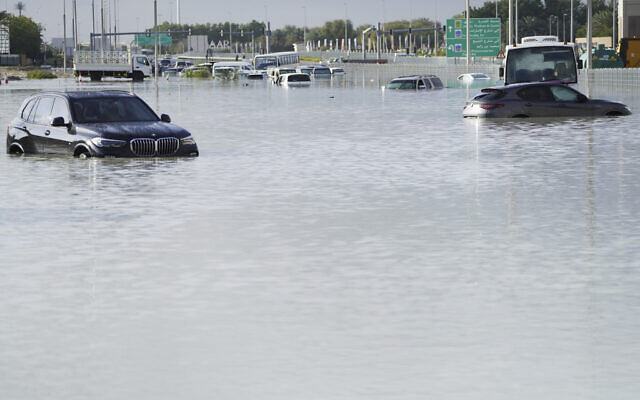Abandoned vehicles in floodwater on a major road in Dubai, United Arab Emirates, April 17, 2024 (Jon Gambrell/AP)
Last month the United Arab Emirates recorded its heaviest rainfall in its history, with the storm striking Oman and then making its way through the rest of the UAE. Initially, the deluge was believed to be an after-effect of cloud seeding, but experts now cite climate change.
Dubai and Abu Dhabi were back on their feet within a few days, but the emirate of Sharjah was submerged under waters for more than a week. The neighborhoods of Al Qasimiya, Abu Shagara, and Al Wahda were the most adversely affected.
Al Qasimiya in Sharjah suffered the most, with relief efforts not arriving for a week later. Streets were submerged under stagnant, toxic water that reached knee-height, trapping residents in their homes. Initially cut off from food and safe drinking water, residents had to wade through the flood, mixed with sewage and dirt, to get essential supplies.
Authorities cited the losses to businesses, but the crisis within the crisis was the health of the populace. Families, including those with young children, suffered from diarrhea and vomiting as the taps and tanks of buildings filled with dirty water. Hospitals tried to cope with an influx of children and adults alike with water-borne diseases.
Vehicles could not reach affected areas for several days. Stuck with dirty, greenish-yellow water from their taps, the residents of Al Qasimiya were left with no choice but get sick. Mr. Parikkutty, an expatriate and resident for around 20 years, described to EA WorldView the challenges of obtaining groceries and essentials.
I had to wade through flooded streets to reach the store. Water levels were above knee-deep, and the
area was beginning to rot.
He suffered from fever and symptoms of water-borne illness: “I felt very weak and lacked energy for two days. Fortunately, I was scheduled to fly out of the country the next day, so my priority was simply to somehow leave the area.” A friend managed to pick him up in an SUV.
Mr. Riyas, a business owner and accountant, was stricken four days after the flood: “Water stored in the underground tank was contaminated due to flood and mixed with sewage water. The
same water was distributed to the flats by pipeline.”
A resident of an adjacent neighborhood, Mr. Hameed said, “Almost everyone in my building was affected by stomach related issues. It started with my 2-year-old son falling ill, and then the rest of our family fell sick one after another.”
Questioned by EA about the seriousness of cases and long-term health implications, a doctor in a Sharjah hospital said the emergency ward continues to receive two to three cases daily, varying from mild to severe. The medic expressed concerns about forthcoming cases of leptospirosis, typhoid, salmonella, and skin
infections. While residents were refraining from tap water for drinking and cooking, its use for brushing and cleaning remains a risk.
Residents and healthcare experts in Sharjah note the role of deficient drainage systems in water contamination. Since many cities across the Gulf have historically not experienced the intensity of recent downpours, there has been neglect of infrastructure, drainage, and management of excess water.
The flooding points to wider concerns about urban planning and climate resilience in the face of changing weather patterns including more frequent and intense rainfall. Although those in less affected areas were able to self-organize as “help groups” and provide assistance and medication for affected families, residents worry that they will not be able to withstand another disaster.
“If the next one strikes,” fears Parikutty, “the situation won’t be pretty. Especially with the area’s poor drainage system.”
He concludes with a voice close to resignation, “I think another storm will be adverse.”

